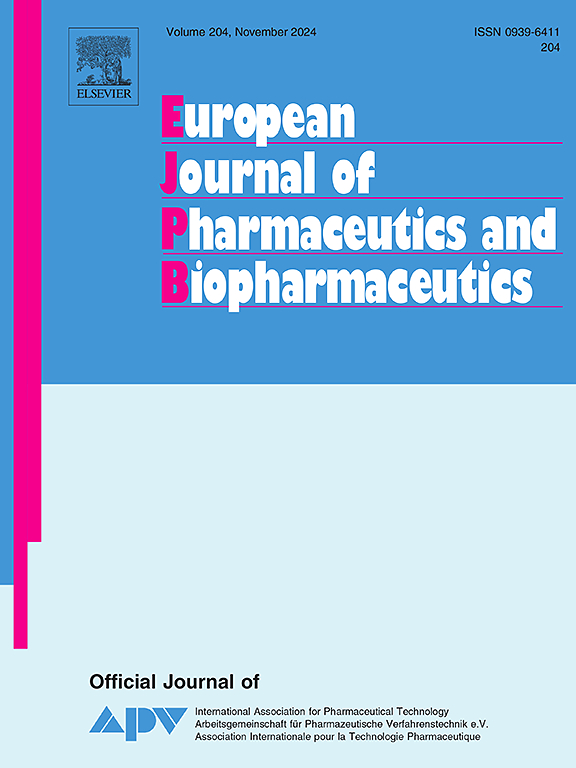辣椒素氨基酸前药改善小鼠大脑和胰腺的药代动力学特性
IF 4.3
2区 医学
Q1 PHARMACOLOGY & PHARMACY
European Journal of Pharmaceutics and Biopharmaceutics
Pub Date : 2025-06-18
DOI:10.1016/j.ejpb.2025.114797
引用次数: 0
摘要
在几种天然产物中,辣椒素已被研究用于治疗各种慢性疾病。虽然它在几种疾病模型中显示出有希望的效果,但高亲脂性和强代谢限制了它的治疗应用于局部注射和局部给药。此外,高浓度的辣椒素会引起严重的不良反应。因此,本研究旨在合成一种利用l型氨基酸转运蛋白1 (LAT1)递送的新型苯丙氨酸衍生的辣椒素前药。提出的前药策略旨在改善辣椒素在大脑和胰腺中的治疗效果,其中LAT1表达。结果表明,通过lat1介导的递送,小胶质细胞、星形胶质细胞和胰腺β细胞的细胞摄取增加了250倍。在体内药代动力学研究中,在小鼠中观察到更稳定的药物递送到胰腺和脑。通过前药设计,将暴露时间从30 min延长至90 min,降低了辣椒素的峰值浓度。新型前药在体外不影响人血浆凝固,也不诱导溶血或活性氧的产生。而脂多糖诱导后,对小鼠前列腺素D2和E2的产生有抑制作用。综上所述,LAT1的使用同时增加了胰腺和大脑的前药递送,从而允许辣椒素的双重靶向。在开发针对大脑和胰腺相互关联的疾病(即神经退行性疾病和糖尿病)的治疗方法时,这是一种有益的策略。本文章由计算机程序翻译,如有差异,请以英文原文为准。

Amino acid prodrug of capsaicin improves pharmacokinetic properties in the mouse brain and pancreas
Among several natural products, capsaicin has been studied for its therapeutic properties to treat various chronic diseases. While it has shown promising effects in several disease models, high lipophilicity and strong metabolism limit its therapeutic use to local injections and topical administration. Moreover, high concentrations of capsaicin cause severe adverse effects. Thus, the present study aimed to synthesize a novel phenylalanine-derived prodrug of capsaicin that would utilize L-type amino acid transporter 1 (LAT1) for its delivery. The proposed prodrug strategy aimed to improve capsaicin’s therapeutic effects in the brain and pancreas, where LAT1 is expressed. The results showed that the cellular uptake into microglia, astrocytes, and pancreatic β-cells increased up to 250-fold by a LAT1-mediated delivery. In the in vivo pharmacokinetic study, more stable drug delivery into the pancreas and brain was observed in mice. By the prodrug design, the exposure time was prolonged from 30 min to 90 min, and peak concentrations of capsaicin were lowered. The novel prodrug did not affect human plasma coagulation, nor induce hemolysis or reactive oxygen species production in vitro. Yet, it inhibited mice’s prostaglandin D2 and E2 production after lipopolysaccharide induction. To summarize, utilization of LAT1 increased prodrug delivery simultaneously in both the pancreas and brain, allowing dual-targeting of capsaicin. This is a beneficial strategy when developing treatment against diseases interlinked in the brain and pancreas, namely neurodegenerative diseases and diabetes.
求助全文
通过发布文献求助,成功后即可免费获取论文全文。
去求助
来源期刊
CiteScore
8.80
自引率
4.10%
发文量
211
审稿时长
36 days
期刊介绍:
The European Journal of Pharmaceutics and Biopharmaceutics provides a medium for the publication of novel, innovative and hypothesis-driven research from the areas of Pharmaceutics and Biopharmaceutics.
Topics covered include for example:
Design and development of drug delivery systems for pharmaceuticals and biopharmaceuticals (small molecules, proteins, nucleic acids)
Aspects of manufacturing process design
Biomedical aspects of drug product design
Strategies and formulations for controlled drug transport across biological barriers
Physicochemical aspects of drug product development
Novel excipients for drug product design
Drug delivery and controlled release systems for systemic and local applications
Nanomaterials for therapeutic and diagnostic purposes
Advanced therapy medicinal products
Medical devices supporting a distinct pharmacological effect.

 求助内容:
求助内容: 应助结果提醒方式:
应助结果提醒方式:


